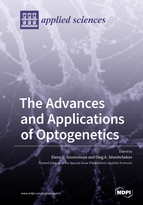The Advances and Applications of Optogenetics
A special issue of Applied Sciences (ISSN 2076-3417). This special issue belongs to the section "Applied Biosciences and Bioengineering".
Deadline for manuscript submissions: closed (31 December 2019) | Viewed by 41723
Special Issue Editors
Interests: channelrhodopsins; optogenetics; neuroscience; cardiology
Special Issues, Collections and Topics in MDPI journals
Special Issue Information
Dear Colleagues,
When Karl Deisseroth coined the word “optogenetics” in 2006, he had in mind using genetically-encoded actuators to control the membrane potential and, thus, cellular excitability with light. Recruiting microbial rhodopsins to this end has yielded a revolution in neuroscience, led to clinical trials to cure blindness and is considered for the treatment of many psychiatric and neurological disorders. Other light-sensitive protein domains, mostly of plant origin, have been harnessed for photoregulation of gene expression, protein activity, oligomerization and trafficking. These efforts have been complemented by engineering proteins to bind photoswitchable ligands. Finally, an array of photosensors responsive to physiological changes in the membrane voltage or intracellular concentrations of specific ions has been created, leading to the possibility of all-optical interrogation of cellular activity. This Special Issue focuses on recent advances in the ever-broadening and exciting field of optogenetics that are expected to boost both fundamental research and clinical practice.
Dr. Elena G. Govorunova
Prof. Dr. Oleg A. Sineshchekov
Guest Editors
Manuscript Submission Information
Manuscripts should be submitted online at www.mdpi.com by registering and logging in to this website. Once you are registered, click here to go to the submission form. Manuscripts can be submitted until the deadline. All submissions that pass pre-check are peer-reviewed. Accepted papers will be published continuously in the journal (as soon as accepted) and will be listed together on the special issue website. Research articles, review articles as well as short communications are invited. For planned papers, a title and short abstract (about 100 words) can be sent to the Editorial Office for announcement on this website.
Submitted manuscripts should not have been published previously, nor be under consideration for publication elsewhere (except conference proceedings papers). All manuscripts are thoroughly refereed through a single-blind peer-review process. A guide for authors and other relevant information for submission of manuscripts is available on the Instructions for Authors page. Applied Sciences is an international peer-reviewed open access semimonthly journal published by MDPI.
Please visit the Instructions for Authors page before submitting a manuscript. The Article Processing Charge (APC) for publication in this open access journal is 2400 CHF (Swiss Francs). Submitted papers should be well formatted and use good English. Authors may use MDPI's English editing service prior to publication or during author revisions.
Keywords
- optogenetics
- photoswitching
- photocontrol
- all-optical electrophysiology
- microbial rhodopsins
- ion channels
- LOV domains
- phytochromes
- membrane potential
- gene expression
- oligomerization
- intracellular trafficking
- protein-protein interaction
- signaling







